21 Best Email Marketing Examples of 2023 (+ Why They Work)
Emjae Williams
If you have an email address you no doubt receive tens of emails from various companies throughout the day.
Some of these emails might be a sales prompt – buy now, grab this discount, don’t miss out – you know the ones. Or they might be a bit more subtle – offering solutions to an issue you have, providing updates on their company. Whatever the nature of the emails, they all fall under one category – email marketing.
Email marketing is not a new concept but it is an evolving form of marketing communication. In simple terms, email marketing is a form of digital marketing that uses emails to promote a business to a set audience.
While there is no one-size-fits-all approach companies can take, there are several email marketing messages that hit the mark and present a valuable learning opportunity.
Here are 21 of the best email marketing examples you can use to guide your own strategy.
The 21 Best Email Marketing Examples
Our examples are a mix of emails sent from companies and entrepreneurs promoting their physical and digital products as well as their services. There are clear differences in the approach used based on what each email is promoting but there are elements they all have in common, particularly their distinct brand voice.
Example 1: Adobe
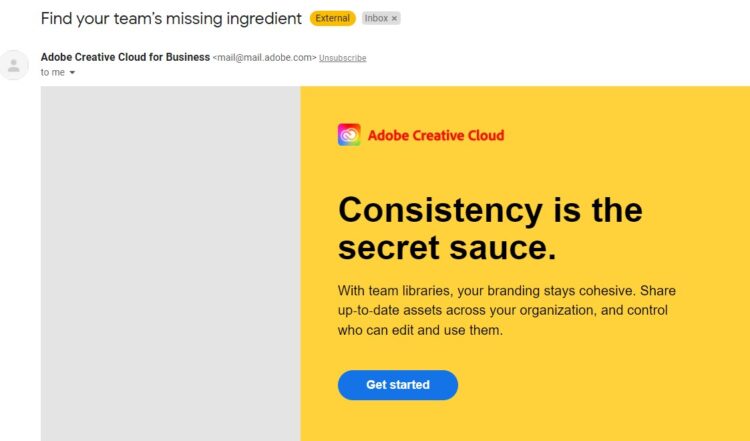
B2B emails can be tricky to get right but when you’re clear on your brand’s objective it’s much easier to craft relevant messages. Adobe knows its niche – digital artists, and it shares content that appeals to them.
Why it works: In this example, Adobe is sharing tips on how teams can collaborate on design projects. The subject line piques curiosity and the main header alludes to the missing ingredient presented in the subject. The purpose of the email is made clear by immediately drawing your eyes to it – it’s hard to miss the big yellow square and bold letters, after all. Though it doesn’t share pricing details, it does take users to a landing page with all the details they need to make a decision. This allows them to keep the email brief without missing the opportunity to share the relevant data.
Example 2: Airbnb
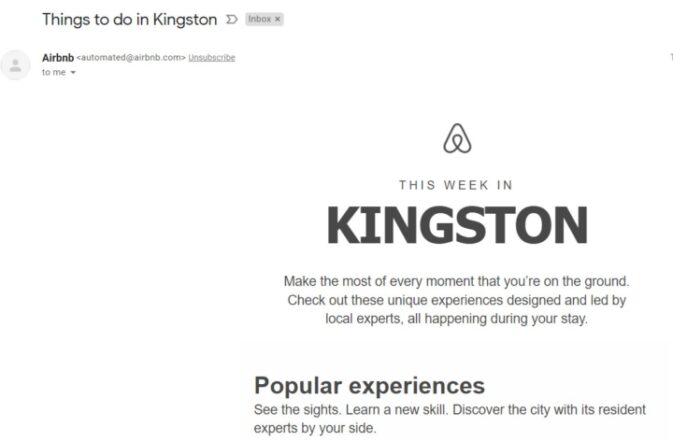
The most successful marketing messages are those that are sent at the right time. Airbnb has mastered this, as is clear from this timely email.
Why it works: The example shared is the kind of email Airbnb sends to users after they’ve booked a stay in a specific location. By sharing ways users can enjoy their stay, they go beyond meeting your explicit need (finding affordable accommodation) to adding value (saving you time by making a list of things to add to your itinerary). This is an effective way to build brand loyalty and brand recall. By sharing this information, Airbnb shows that they are more than a booking site – they are also your tour guide and coordinator.
Example 3: Animoto
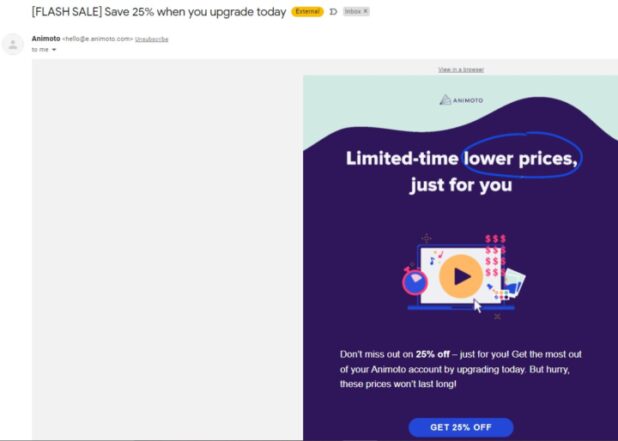
When consumers are bombarded with sales messages it’s easy for yours to get lost in the inbox. One way to stand out is to make your offer clear and enticing before they even open it.
Why it works: Animoto was very transparent in their subject line. They included what they were offering (a 25% discount), when it was being offered (today), and how to receive it (by upgrading). The inclusion of ‘flash sale’ served as an attention grabber because it appeals to your fear of missing out (FOMO). The artwork then re-emphasizes these points and includes a clear call to action. The messaging is also well-done as it makes it feel as though this deal was specially created ‘just for you’.
Example 4: Asana
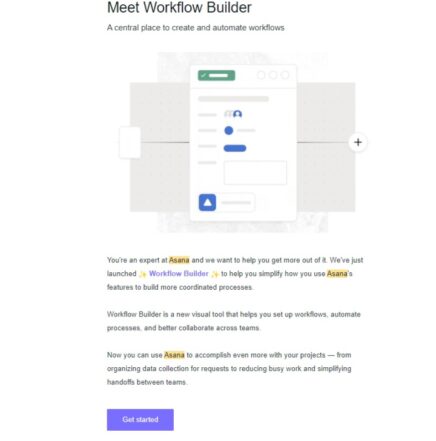
Launching a new product or service to existing customers can be hit-or-miss. Asana’s approach to their Workflow Builder launch is an example of how to do it effectively.
Why it works: Asana immediately announces the name of the new product in the main header and gives an idea of what it is. They then move on to acknowledge the user’s past experience. ‘You’re an expert’ shows that they know you’ve been actively using the product, ‘and we want to help you get more out of it’ makes it clear that this new offer will be an additional benefit. Finally, they give additional details about the product and end with a clear call to action. No assumptions were made and this led to a well-crafted product introduction that piques interest.
Example 5: Audible
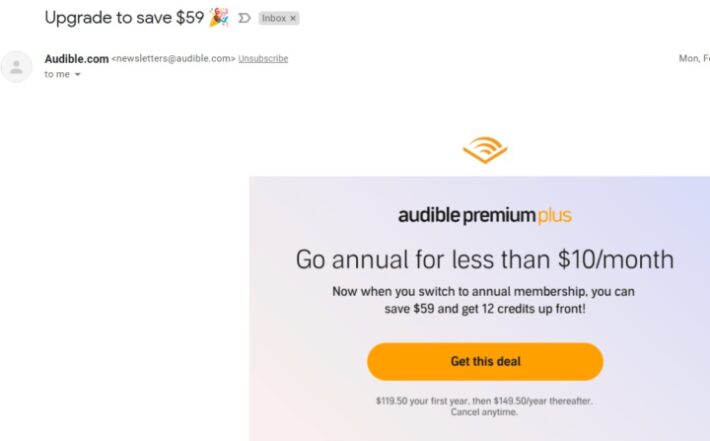
When pitching an offer or sharing a discount, the last thing you want to do is leave the reader confused. The most effective messages anticipate their immediate questions and provide answers for them, just like Audible does in this example.
Why it works: Audible does not leave their customers guessing – they get straight to the point and keep the email succinct. This email is one that is sent to existing subscribers who will now be benefiting from a discount by upgrading their plan. All the relevant information is readily available – the product, the offer, the benefit, how to claim it, the conditions, and the call to action is clear. The inclusion of the regular price vs the discounted price is a nice touch in appealing to their audience’s desire to get the best deal.
Example 6: Canva
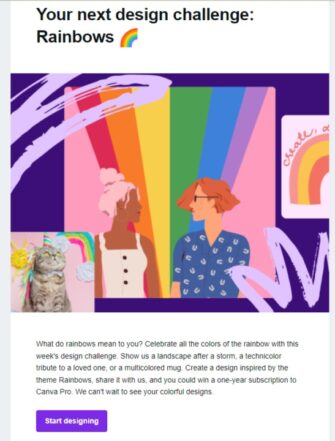
How do you get subscribers to use your services without explicitly telling them to use your services? Do what Canva did and launch a challenge!
Why this works: Canva’s design challenge has a clear goal – get more people to use the product. By issuing a design challenge with elements only found on their platform, they prompt users to do just that. But they also include a prize – a free 1-year subscription to Canva Pro. They make the steps to enter clear, simple, and easy to follow to remove some of the barriers that would hinder participation. Without including a hard sell, Canva will no doubt see an uptake of users signing up, possibly even paying for a monthly subscription to access better features for this design challenge.
Example 7: Chandler Bolt
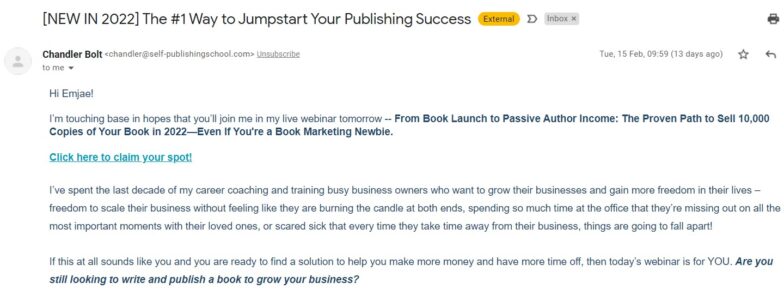
If you receive long emails you know what it feels like to skim through, not see anything that makes it worthwhile, and quickly delete the message. Chandler Bolt found a way to grab his reader’s attention, pitch his offer and then give details.
Why this works: Chandler included a clear call to action in the first few lines of his email. If the reader has no interest in the additional details shared in the body of the email, he wouldn’t have lost that opportunity to move them to the next step. As a bonus, his email subject gives a hint to the content within the email so readers can decide before opening it if this is something that interests them.
Example 8: CoSchedule
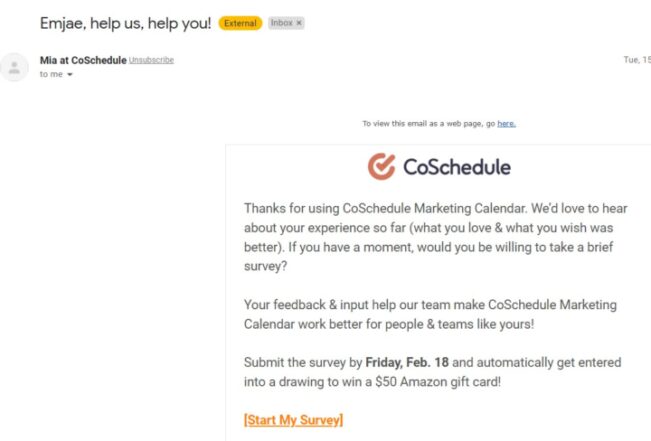
Personalization is an extremely effective way to grab your reader’s attention. CoScheduler knows that getting people to agree to surveys is not an easy feat so they took this more personal approach.
Why this works: In a sea of promotional emails and updates, their name will stand out, especially when you’re asking them to make time to do something on your behalf. They also play on the ‘what’s in it for me’ sentiment in their subject line by adding ‘help you’. This makes it clear that whatever the email is about will ultimately be of benefit to both of you. The body of the email is also clear on what they need and how you can benefit – tell us how we’re doing and you might win a gift card.
Example 9: Fashion Nova
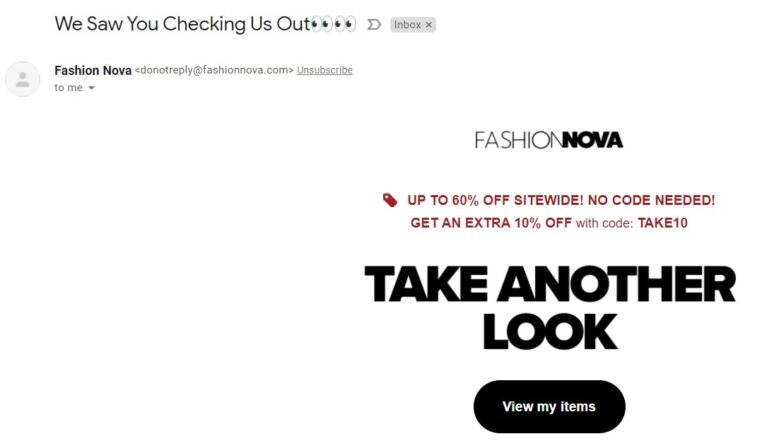
Abandoned cart emails can result in one of three things – getting the customer to revisit the site, having the customer ignore you, or worse – they’ll unsubscribe and never return. Fashion Nova found a subtle way to prompt their customers to ‘check out’ their email.
Why this works: The subject line is not forceful – it comes across as playful, a little cheeky and the inclusion of emojis further softens the tone. Despite not being the first thing stated, it’s clear what they want you to do – take another look at what you left behind. They also make mention of sales and discounts that are currently available to make it more enticing to revisit the cart. This is also a great example of marketing automation and how you can use email marketing to connect other aspects of your marketing strategy.
Example 10: Grammarly
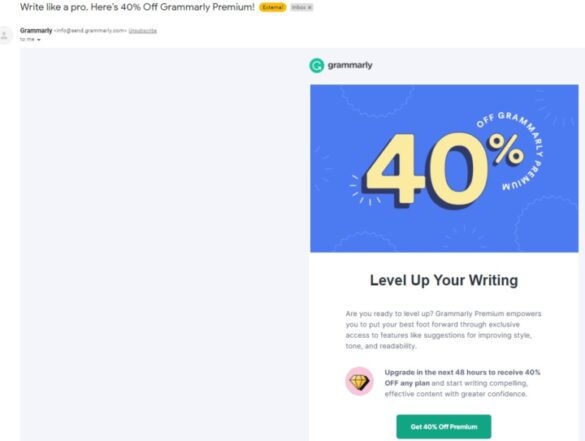
If you’re offering a discount it needs to be something users either need or want… and you’ll need to make that clear. Grammarly’s discount email is an example of how that can be done with just the subject line.
Why this works: Most people love discounts but being offered a discount arbitrarily for a product or service they don’t need isn’t very effective. Grammarly manages to tell you what the benefit is to upgrading (write like a pro) and what the offer is (40% off) right in the subject line. The body further shares the offer and also provides a comparison with their free and premium plan to emphasize the importance of upgrading, building on what was hinted at in the subject. A rule of thumb is to never mislead your readers by using a heavily ‘click-baited’ subject line. In Grammarly’s case, they delivered on what was promised.
Example 11: LinkedIn

If you can reach a potential user at the point of consideration, half your battle is already won. It’s easier to convert someone who has a genuine interest in your product and LinkedIn has found a way to capitalize on this.
Why this works: In the example shared, LinkedIn is re-engaging with a user who just viewed their product. By timing this email perfectly, they can build on the existing interest and potentially lead the user to purchase. Rather than lead with an offer, they pull you in with a personalized email subject and an acknowledgment of your interest. Some companies take this approach to ensure readers aren’t only being enticed by the free offer but have a genuine interest in their product. The email body continues to build on this gratitude but now there is a clear offer that stands out as soon as the email is opened.
Example 12: Litmus
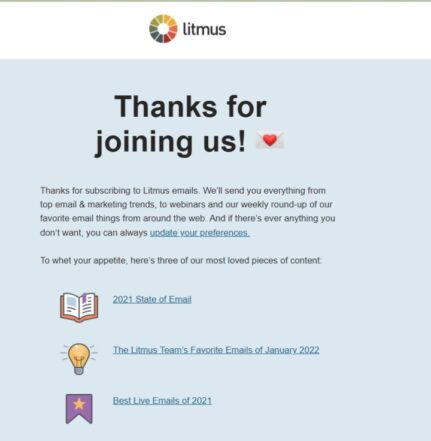
Having someone join your email list does not necessarily mean they know what your company is about. Litmus’ thank you email is an example of how welcome emails can be crafted to quickly create a connection and sense of familiarity.
Why it works: Litmus sets their reader’s expectations with the very first email – what topics they’ll cover and how frequently updates will be shared. They also include a clear unsubscribe option so you can choose to opt out if those topics aren’t of interest. The inclusion of samples of their content allows readers to get a better sense of what they’ll be receiving. Readers don’t need to wait to get the information they signed up for and this builds anticipation for what’s to come in the regular updates.
Example 13: Loom
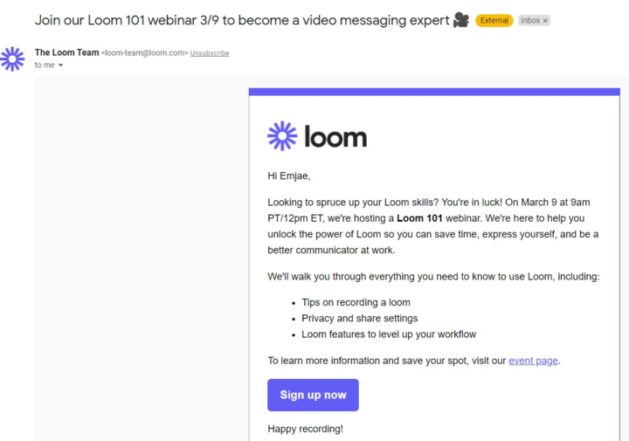
It’s not advisable to assume that your users or customers completely understand what you offer or how to use your products. Loom acknowledges that there’s more their users can learn and addresses this as they pitch their training offer.
Why this works: Loom makes it clear what they’re offering from as early as the subject line – a webinar to help clients use the platform better. The body of the email starts with a question that prompts readers to think about whether or not they could be using the service in a more efficient way. This puts them in the mindset to be open to the offer Loom has – a webinar that teaches you how to make the most of its features. The CTA included is clear and to the point, an approach that tends to result in more clicks.
Example 14: Peta from Professional Babe
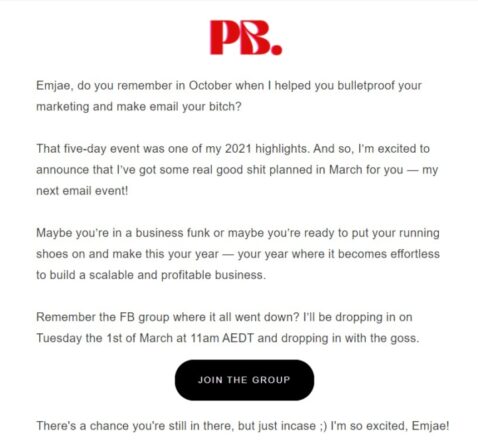
When you know your audience, really know them, you can use a tone that appeals directly to them. Peta from Professional Babe has built her brand taking an unconventional approach to marketing and it shows in her emails. Her messages sound more like a friend checking in than a business trying to pitch you an offer.
Why this works: It’s always a breath of fresh air to read an email that sounds like it’s from a person. In this example, Peta recalls past events where she connected with her reader rather than jump into the pitch. She doesn’t make the assumption that her brand is at the forefront of your mind but does play on the memory you might have of your most recent interaction. Then she begins to connect the dots and slowly leads you to the pitch, all while infusing the message with her unique brand tone.
Example 15: Really Good Emails
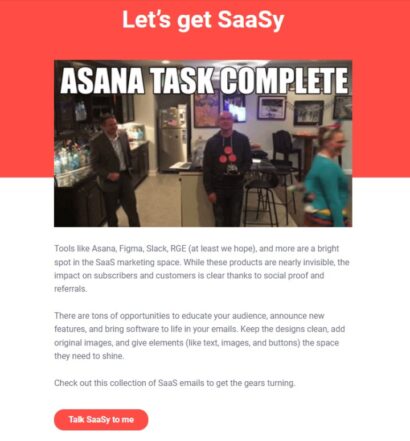
Long gone are the days when emails needed to be uptight, stuffy messages. More companies are finding ways to include the fun side of their brand in these forms of communication by using puns and gifs – like Really Good Emails does in this example.
Why this works: This email makes it clear who Really Good Emails is and who they’re speaking to. If this was the first email of theirs you read you’d get the sense that they are relaxed and a little silly but still focused on sharing valuable information. They sandwich the details of the email with their fun tone and use an unconventional call to action that will stand out just for how different it is. You can tell that while they aim to inform, they don’t plan to bore you. Incorporating your brand’s personality in your messages is a great way to ensure you’re reaching the ideal audience.
Example 16: Shopify
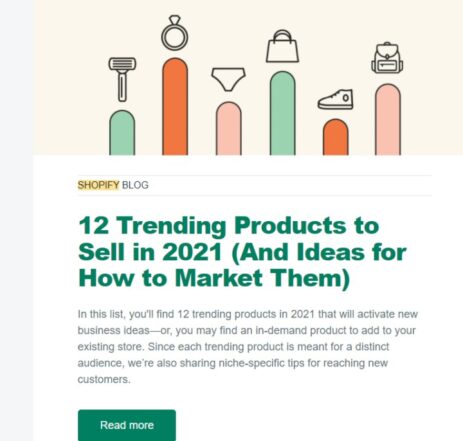
One of the most effective approaches a B2B company can take is to position themselves as a thought-leader. Shopify has leaned into this and their email marketing strategy includes a mix of hard-sell and informative pieces.
Why this works: By sharing useful information you’re able to build brand loyalty and brand recall. It shows that you’re aware of your customer’s problems and are willing to provide them with solutions. Shopify is known to be one of the best e-commerce platforms for entrepreneurs and small businesses and they use their email marketing strategy to enrich these users by providing them with the information they can use to grow their businesses. While it might not lead to an immediate sale for Shopify, it will keep them top of mind when customers are faced with an issue.
Example 17: Skillshare
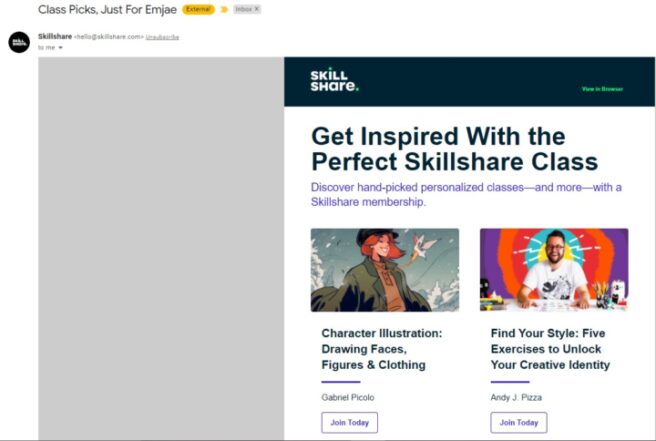
Personalization goes beyond just including your reader’s name in the email. To really hit the mark you need to prove that you’re in tune with their needs and interests, much like Skillshare has done.
Why it works: Skillshare tracks the courses and topics their users are interested in which gives them insight on what to share with them. Personalizing the email subject has the benefit of making the email stand out but the real seller is having personalized content. It makes it clear that the company is paying attention and makes the user feel as though they matter. It also saves them the trouble of filtering through numerous courses and this could make it more likely for them to commit to a purchase. If you offer multiple courses, products, or services, find ways to share those that are most relevant to your users.
Example 18: Sparkpost
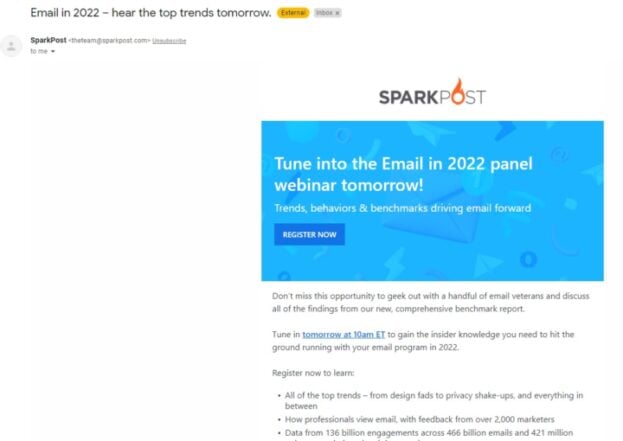
SparkPost is another example of a B2B company that knows its audience – they require convenient, straight-to-the-point communication. For an event announcement, there doesn’t need to be a lot of fluff.
Why it works: SparkPost knows that their users need to quickly get the relevant details so they can take action and get back to their day. In this example they led with important information in the email subject – what they’re sharing (information about 2022 email trends) and when (the following day). The most relevant details are immediately identifiable in the body of the email – a summary of the event and a call to action, so readers can skip the details if needed. At the same time, they’ve ensured that if you do need additional information it’s easily accessible. This is a great example of how to effectively meet your reader’s needs for both convenience and information.
Example 19: theSkimm
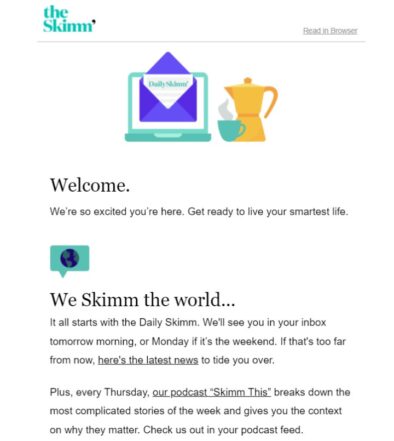
If you’ve ever subscribed to an email list, forgot about it, and been confused when you start receiving their updates, then theSkimm’s welcome email will be a relief. It serves as a great introduction to a new company and is an approach to be inspired by.
Why it works: theSkimm sends this email as soon as you subscribe and it serves to notify you of the subscription and to introduce themselves. They set the expectation for what you’ll receive and include links to view their latest content so you can decide if you want to stick around. The body of the email breaks down all the areas they cover, shares details about their referral program, and ends by letting you know your first update will be sent the following day. An effective welcome email gives your audience all the information they need to reassure them that they’re in the right place.
Example 20: Vimeo
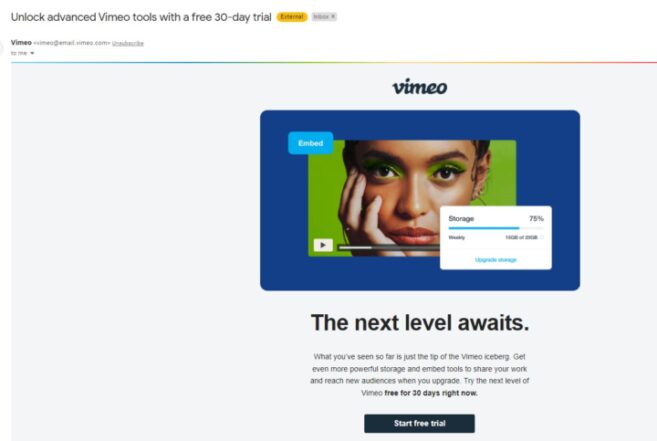
So your subscriber is already using your services and you’d like them to upgrade to a paid plan. Do you A) tell them to upgrade or B) show them why they need to? Vimeo chose the latter and it’s an effective approach for a few reasons.
Why it works: The email leads with a clear offer – a free 30-day trial. The body then builds on this by highlightinging that there’s much more to Vimeo than the user has experienced (just the tip of the iceberg) and then sharing the benefits they can enjoy (more storage, better embeds, more reach). There’s a clear call to action to immediately grab those users who are ready to commit but additional details are also included to sway those who need more persuading. The tone isn’t forceful but is more advisory, making it feel more to the reader that the decision is theirs to make.
Example 21: Zoom
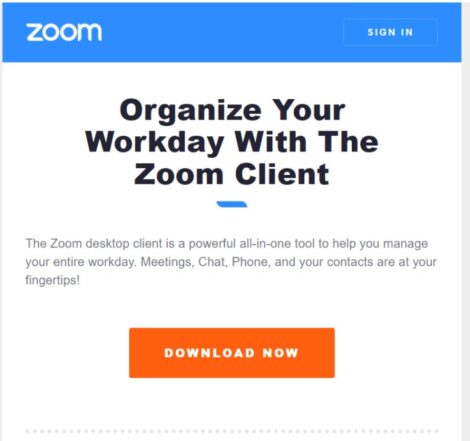
Sometimes the most effective approach is to get straight to the point, especially if your audience is known to be the type who is constantly on the go. Zoom’s main target audience is workers who might not necessarily have time to scroll through a long email and they use this insight to their advantage.
Why this works: By getting straight to the point and requiring one simple action, Zoom makes it easy for its readers to decide what step to take. There are two options – download the book or don’t download the book. The bold header already shares what the material is about but for those who need more information, they provide that right below. It’s particularly important to keep emails brief because readers might be daunted by the length of the email and exit before getting to the CTA.
Including Email Marketing in Your Strategy
The examples shared here only begin to brush the surface of effective email marketing approaches. These can be used as a guide for your own strategy as these principles can be applied to any industry or service.
If you’re new to email marketing, you’ll first need to learn more about the basics and best practices. With this knowledge, you’ll be better equipped to include email marketing in your overall strategy in order to maximize your business’ potential. Also, if you are looking for email marketing services, consider checking out some of the best email marketing agencies that can rapidly boost your campaign performance.
Whatever approach you choose, be sure that it is true to your brand and effectively serves your ideal audience.